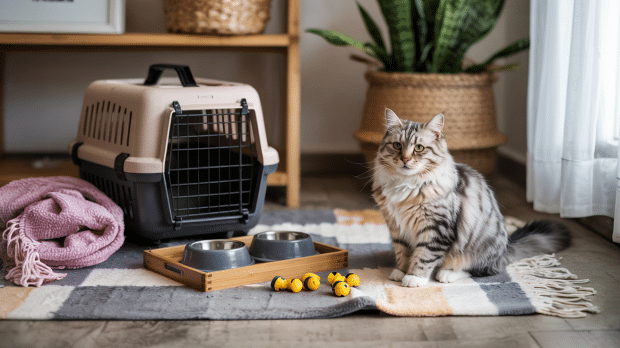I remember the first time I moved with my cat. Boxes were stacked high, everything smelled different, and she hid under the bed for hours.
That experience taught me just how sensitive cats are to change. If you’re preparing for a move, there are several steps you can take to help your cat feel secure.
This guide walks you through what worked for me: packing early, setting up a quiet room, and giving your cat time to adjust.
You’ll learn how to ease the stress before, during, and after moving day with calm steps that fit into your routine.
Moving isn’t easy, but with a little planning, you and your cat can settle in without too much trouble.
Cats and Moving to a New Home

Moving can feel strange and confusing for your cat. Changes in surroundings, smells, and routines can create stress, even if the new home is safer or quieter.
To help your cat adjust, keep familiar items like beds, toys, and feeding bowls nearby from day one. Try to stick to your usual feeding and play schedule.
Give your cat time to explore the new space slowly, one room at a time. A calm, quiet area where they can retreat helps reduce anxiety.
Talk to them gently and offer extra affection. With patience and steady care, your cat will begin to feel more secure in their new environment.
Before You Move
Start preparing a few weeks in advance to help your cat feel safe. Please set up a quiet space with their usual things and keep their daily habits the same.
This will make the change feel smaller and less upsetting. A little planning now can make a big difference later when it’s time to go.
Prepare a Carrier and Familiar Items
Make sure your cat has a sturdy, well-ventilated carrier ready for moving day. Leave it out early so they can get used to it.
Add their favorite blanket or bed inside to make it feel like home. Bring along items they sleep on, play with, or use often, like toys and scratching posts.
These smells and textures help your cat feel safe and reduce fear during the move.
Visit the Vet if Needed
A vet visit can help you plan for a smooth move, especially if your cat is older or gets nervous easily.
If your cat takes any daily medications, get enough to last through the move and the first few weeks after. A quick check-up can give you peace of mind.
Keep Things Routine
Cats feel safer when their schedule stays the same. Keep feeding times steady, and avoid loud noises or sudden changes in the home before the move.
Stick to calm interactions and quiet playtime. If your cat senses that you’re relaxed, it’s more likely to stay calm, too.
Routines create comfort, even when the world around them starts to shift.
Moving Day Plans
The goal is to keep your cat safe and calm during the move. With doors open, people walking around, and loud sounds, it’s easy for a cat to feel scared or try to hide.
Set up a clear plan so your cat stays out of the chaos and feels more at ease.
Confine to a Quiet Room or Carrier
Before the movers arrive, place your cat in a quiet room with the door closed, or secure them in a carrier.
Choose a space that won’t be disturbed, like a bathroom or an empty bedroom. Add their food, water, litter box, and favorite items.
This limits stress and prevents them from escaping. A calm, closed-off area helps them stay safe while the rest of the home is packed up and loaded.
Transporting Your Cat
Use a strong, well-ventilated carrier designed for travel. Line it with a soft towel or small blanket that smells like home.
This helps reduce stress during the ride. Keep the carrier level and secure in the car so it doesn’t slide around.
Speak in a calm voice if your cat meows or seems uneasy. A quiet, smooth trip helps them feel safer while everything changes around them.
First Days in the New Home
The first few days in a new place can be confusing for your cat. New smells, sights, and sounds may feel overwhelming.
Start small and give them time to adjust. A calm, steady approach helps them feel secure. Your patience and care will help your cat settle in at their own pace.
Start With One Safe Room
Choose a quiet room for your cat to stay for the first few days. Set up a litter box, food, water, bed, and a few hiding spots, such as a box or blanket-covered area.
This small, calm space gives your cat a sense of safety. Visit often, but let them rest if they need it. Keeping things simple and familiar makes the adjustment easier for them.
Let Them Come Out When Ready
Give your cat time to explore the new space on their terms. Don’t pick them up or try to make them come out from hiding.
Let them watch from their spot and move when they feel ready. Keep the area quiet and limit visitors during this time.
Watch from a distance and speak softly. Their comfort will grow as they build confidence in the new home.
Helping Your Cat Adjust

Your cat may take days or even weeks to feel comfortable in the new home. That’s normal. What matters most is keeping things steady and offering a quiet space to settle in.
A familiar routine, gentle care, and small comforts will help your cat feel safe as it adjusts to its surroundings.
Keep to a Familiar Routine
Cats rely on routine to feel safe. Stick to the same feeding times each day, and don’t skip play sessions.
Even if everything else has changed, keeping their daily habits the same gives them something steady to count on.
This helps your cat feel more in control. Be patient, and try not to change things suddenly during this early adjustment stage.
Add Comforting Smells
Familiar smells can help your cat feel calm. Spread out items from your old home, such as used blankets, your bed, or even your worn clothing.
These familiar scents remind your cat of safety and normal life. Please place them in rooms where your cat spends time. They’ll create a sense of comfort as your cat learns the new space.
Use Calming Tools if Needed
If your cat seems unusually stressed, you might try calming aids. Products like pheromone diffusers can help lower tension and make the home feel safer.
Some cats also respond well to treats or sprays meant to ease stress. Ask your vet before trying new products, especially if your cat has health issues.
Letting Your Cat Explore
Once your cat feels safe in its first room, you can start letting it see more of the house. Take it slow and watch how it responds.
Expanding their space too quickly can cause stress. Go at their pace, and offer comfort and quiet while they learn their new surroundings.
Open One Room at a Time
Begin by opening one new room and letting your cat explore while you watch. Stay nearby and speak in a calm voice.
Bring along their favorite toy or blanket to make the space feel familiar. Don’t rush or carry them from room to room.
Let them walk around at their own pace. This slow process helps your cat build confidence without feeling overwhelmed.
Outdoor Cats Need Extra Caution
If your cat is used to going outside, hold off for at least two weeks after the move. Let them adjust indoors first.
When the time comes, begin with short trips outside under supervision. Choose quiet times of day and stay close.
Consider keeping them safe with a harness or in an enclosed space. Once they feel secure, you can slowly allow more freedom over time.
Special Cases
Some cats need a little more help when moving to a new home. Older cats, anxious ones, or homes with more than one cat can present added challenges.
With extra care, quiet spaces, and steady routines, you can help each cat feel secure and supported through the move and beyond.
Moving With Multiple Cats
If you’re moving with more than one cat, it’s best to give each one their own space at first. This prevents tension caused by stress and unfamiliar smells.
Set up separate rooms with their food, litter, and bedding. After a few days, you can slowly reintroduce them by swapping bedding or allowing short visits.
Go slowly, and watch for signs of discomfort or aggression.
Older or Anxious Cats
Older or more anxious cats may need extra care during and after the move. Monitor their behavior closely.
Signs like hiding more than usual, refusing to eat, or suddenly acting aggressively may indicate that they’re feeling overwhelmed.
Stick to simple routines and offer comfort. If issues continue, speak with a vet to rule out health concerns or discuss stress-reducing options.
Conclusion
By now, you’ve got a solid plan to help your cat through the move, one simple step at a time.
I’ve found that a bit of patience, a steady routine, and a quiet space make a big difference, especially in those first few days.
Your cat may need extra time, but they’ll start to feel more at home as long as you move at their pace. Familiar smells, gentle care, and calm surroundings help them settle in faster.
Want more tips on pet care, behavior, or daily routines? Check out other blogs for helpful ideas that make life easier for both you and your cat.
Frequently Asked Questions
How long until a cat adjusts?
Most cats adjust within one to three weeks, but some may take longer. Patience and a steady routine help.
Should I let my cat outside at the new home?
Wait at least two weeks, or longer if your cat seems unsure. Always supervise the first few outings.
What if my cat won’t eat?
Stress can cause a loss of appetite. Try offering familiar food and quiet time. If it lasts more than a day or two, contact your vet.
Can cats find their way back to their old home?
Yes, some may try. Keep them indoors for several weeks, and update their ID and microchip with your new address.






